
The Linguistic Landscape Analysis of the Jingting Plaza and Tianle Place of Korean Street
(韩国街) in Shanghai, China
Photo “Look” by Zhang Cheng
by Enkhjin Nerguibaatar
Read the Faculty Introduction.
Abstract
The identity of a specific region is defined by its semiotics, particularly its linguistic landscape, which represents the residents and culture. Using the evidence that Korean culture has been prominent around cosmopolitan cities like Shanghai, this study explores the Korean language representation in Korean Street (韩国街) located in the Minhang District in Shanghai, China, as Korean immigrants densely inhabit it. I hypothesize that the repetition of Korean language usage in signs can elucidate language predominance and the presence of Korean culture representation in Shanghai. By utilizing Scollon and Scollon’s theory of semiotics as the main method of analysis (Scollon and Scollon 91), the linguistic landscape of Korean Street depicts predominance in the Korean language. The multilingual usage of commercial and noncommercial signs on buildings reflects the presence of Korean immigrants and the representation of their culture by adopting both Korean and Chinese languages in the signage. Therefore, this study explores the diversity of signs on commercial buildings on Korean Street as an attempt to extend the understanding of multilingualism in a regional context by analyzing the linguistic landscape.
Introduction
In recent years, the focus of sociolinguistics research has shifted toward the linguistic landscape of urban areas. The written language on the sign transmits information to an “unspecified group of in public space” (Backhaus 8) and it can convey and represent meaning since it is permanent. The linguistic landscape study refers to the social environment where multiple languages are used, and the signs of large cosmopolitan cities are linguistically diverse and representative of local culture (Huebner 32). The linguistic landscape of cosmopolitan cities in China, Shanghai, and Guangzhou (An and Zhang 2), are currently being studied. Shanghai is considered the cosmopolitan capital of China with around 19 million people in an area of around 6,300 square kilometers. It is a “cosmopolitan, entrepreneurial metropolis” (Wang 87), also a global hub in East Asia (Ye and Jeon 2).
According to statistics released in 2018 by the Consulate General of the Republic of Korea in Shanghai, there are a total of 32,000 Korean nationals residing in Shanghai, accounting for 15% of foreign residents. This study explores the multilingual landscape of Korean Street (韩国街) which is located in Minhang District, Hongquan Road, and it is one of the most concentrated international communities in Shanghai with 10,000 Korean people. The study of the linguistic landscape holds significant importance, particularly as it represents a public space where various aspects of social life are investigated (Ben-Rafael 41). Therefore, the linguistic landscape research of Korean Street provides insight into the understanding of the linguistic diversity of this region. First, by categorizing the language representation in signs based on their combinations, this study provides a general understanding of the linguistic landscape of Korean Street and its linguistic diversity. Second, by understanding the linguistic diversity of this region, this study explores the arrangement of visual semiotics of signs which can elucidate the relationship between multilingual signs and local cultural representations.
The significance of this study lies in its examination of the understudied linguistic landscape of Korean Street, a cultural landmark for the Korean community and a renowned tourist attraction. Through the categorization of sign language representation by combinations, this study aims to offer insights into the linguistic diversity of Korean Street and provide a comprehensive overview of its linguistic landscape. As such, this study highlights the linguistic character of the Korean Street, particularly in metropolis cities like Shanghai, China.
The linguistic landscape is perceived as the representation of a certain region (Ben-Rafael 42) and visitors remember the characteristics and special elements of the specific area through its semiotics. The research questions that this study aims to address are:
- How do the Korean-Chinese and Korean-English signs in Korean Street (韩国街) reflect the linguistic representation of the Korean community in Shanghai and contribute to the broader linguistic landscape?
- What are the patterns of language use on signs in Korean Street?
Linguistic Landscape Studies
The study on Tokyo conducted by Backhaus (Backhaus 53) indicates the historical significance of the language around the signs in Tokyo, analyzing the geographical correlation between semiotics and multilingualism by emphasizing the accessibility of the languages. Also, the comparative approach to exploring the diversity of Tokyo’s linguistic landscape in different neighborhoods and defining the identity of the environment. Backhaus’s analysis can reflect geographical correlation and how the region intends to be represented, specifically on Korean Street, where Korean and Chinese languages are commonly used. Since the signs of Korean Street have linguistic variations, the accessible language can be established by the language and representation of the Korean community in Shanghai.
According to the sociological study of the linguistic landscape by Eliezer Ben-Rafael, the linguistic landscape qualifies as a “social fact” and the elements in the linguistic landscape provide information about the particular place, thus it is a gestalt (Ben-Rafael 43). The individual multilingual signs with different variations of languages are studied by observing the languages on the signs, which are Korean-Chinese, Korean-English, and monolingual signs. As such, the variety of languages and elucidation of the predominant language in those signs illustrate the “whole” identity of the region where the signs have been studied. Therefore, the whole identity of Korean Street can be elucidated by the linguistic environment and the relationship between signs and languages.
The “symbolic value condition,” which reflects the preference for the language written on signs and other public displays, illustrates the intention of how a specific sign wants to be identified. Thus, the language choice of multilingual signs in the study area can be identified using this “symbolic value condition” (Spolsky 33). In some cases, monolingual usage of signs demonstrates that it is following local regulations of signs, thus it represents the governmental signs. For example, a sign with only the Korean language is either a copy of the original brand advertisement or targeted toward the Korean audience. Therefore, the language preference among the multilingual variations provides information about the context and what the sign is indexing. The patterns of commercial signs on Korean Street can indicate the identification of the environment and the intention of how Korean signs want to be conveyed. As such, Korean cultural representations and language prominence in Korean Street can be recognized by the condition of the sign.
In their research on Bangkok’s linguistic landscape, Huebner examines the linguistic landscapes with a specific emphasis on the presence of environmental print and the use of contact languages (Huebner 48), including Thai, English, and Chinese, in public areas. The author contends that these linguistic features signify the evolution of language and the emergence of a more all-encompassing Thai identity that acknowledges linguistic diversity (Huebner 50). The linguistic diversity of Korean Street reflects the interaction between Korean and Chinese languages and how this language contact contributes to the status of languages in the study area.
Methodology
For the analysis of Korean Street, photographs of signs were collected and analyzed. Over 80 pictures of the signs were taken, including shop signs, road signs, and other signs within the visible scope of the study area. The variation of languages and linguistic contact of the signs were considered. The linguistic variations on the signs included Korean-only, Korean-Chinese, Korean-English, and Korean-Chinese-English trilingual signs.
The overall study area considered Jingting Building as the main point since it has been established as the central section of Korean Street (YICAI 2020). The perimeter of the study took commercial buildings for analysis because the commercial area (Figure 1) is bordered by the Jinxiu Jiangnan residential area which is 300 meters east of the Jingting Plaza. Therefore, commercial buildings in proximity to the Jingting Building have been taken into consideration such that mostly commercial signs are taken into account in this study.
Photographs were taken of the signs located on the Jingting Building, situated on Hongquan Road to the east, and Tianle Place, situated on Yinting Road to the north. Moreover, a total of 6 buildings were covered and analyzed in the study area. Jingting Plaza and Tianle Plaza were taken into consideration because these buildings are the market hub and the main tourist attraction of this area, the remaining buildings are hotels and other commercial buildings that are less crucial than the market hubs.
The study analyzed the signs on the exterior side of Jingting Plaza, also known as Jingting Seoul Plaza, located at Hongquan Road. The interior signs also represent the environmental print of Jingting Plaza; however, the signs on the exterior side of buildings were chosen as a “social fact,” to convey the direct visual perception of the visitors and demonstrate the language used on public display. The east side of the Jingting Plaza is where Shanghai Fortune Hotel is located, and it is a Chinese hotel with multiple multilingual signs which suggests the significance of the Korean language as the identity or essential element of this region.
Tianle Place is located at Yinting Road, and it is a square-shaped building with a myriad of restaurants and stores, which indicates the end of Korean Street because the buildings beyond this area are apartment complexes and other government buildings. The photographs of the signs were collected, and the collected data match the variety of languages on Korean Street.
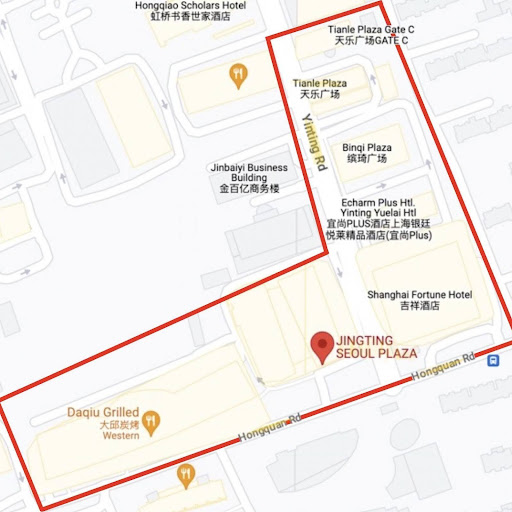
The Variation of Languages on the Signs of Korean Street
The determination of language prominence in multilingual signs is distinguished by the placement and composition of the sign (Huebner 35), and the composition of the sign plays an essential role in signifying the variation of languages. Moreover, the language mixing was observed in the name of the sign and lexical borrowing of the Korean language was also discerned. The variation of languages reveals the identity of the region, as such the Korean language is abundant in this area compared to the other areas in Shanghai, which use Chinese as the main language. Though the predominant use of the Chinese language can be seen in surrounding areas, the Korean also co-exists with other parts of Shanghai and does not elicit such bilingual scenarios. The Korean “한글” (hangeul) and Chinese “汉字” (hanzi) characters are predominantly used in signs and brochures on Korean Street. The variations are (a) Korean-Chinese signs, (b) Korean-English signs, (c) Korean-Chinese-English signs, and (d) Korean-only signs.
Korean-Chinese Signs
The prominent language in the multilingual signs is analyzed by Scollon and Scollon’s theory on the composition and modality of visual semiotics. In Figure 2, “제주식당” (je ju sik dang) in Korean and “济州食堂” (ji zhou shi tang) in Chinese are written on this sign, and then the Korean name is repeated at the bottom right corner. The Korean letters are color differentiated, and written in a bigger font, and their prominence is determined as the text is placed above the Chinese characters. According to the composition diagram by Kress and van Leeuwen (Scollon and Scollon 91), the bottom right corner indicates “real and new” information while the placement of the main idea or logo tends to be placed at the bottom right corner. Therefore, the main language of the sign in Figure 2 is Korean.
Moreover, in Figure 3, the characters of both languages are placed adjacent to each other in such a manner that prominence is determined by the sign’s modality. “날마다쏘맥” (nal ma da so maek) is positioned at the central part of the sign and is reiterated in the logo. “실내포차” (sil nae po cha) and “室内大排档” (shinei da pai dang) hold the same meaning in both languages and are positioned on either side of the Korean text. Additionally, “sil nae” and “shinei” convey the same meaning in Korean and Chinese, suggesting potential lexical borrowing from either language. “哈啤哈烧” (ha pi ha shao) is placed on the right side of the logo, and the Korean text exhibits color modality and different character placement to establish its prominence. Therefore, the Korean language is the main language of this sign.
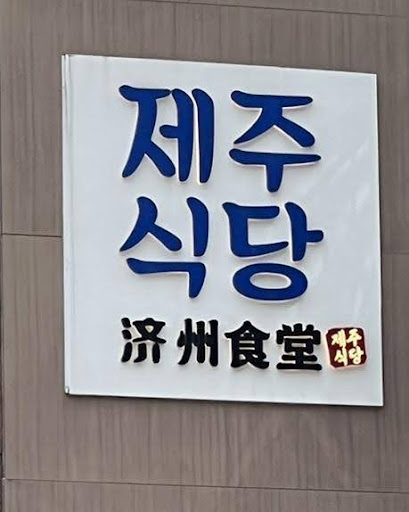

However, the prominent language in Figure 4 is Chinese because of the position and modality of the text. “厨房用品” (chufang yongpin) in Chinese is at the top of “남영주방” (nam yeong ju bang) in Korean, and the Chinese text is written in bold which suggests that it is the prominent language of this sign. Also, other Chinese texts are placed on the right side of the sign which are “厨房用品” (chufang yongpin) and “生活用品” (shenghuo yongpin) is “new information” (Scollon and Scollon 92) which supports and adds a new idea to the central Chinese text. As such, the Chinese text gives more information than the Korean text so one could argue that Chinese is the prominent language in this sign.

Korean-English Signs
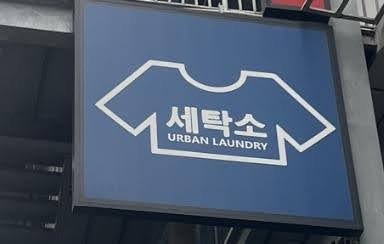
The use of English in Korean-prominent signs is scarce in this region. In Figure 5, “세탁소” (sae tak so) in Korean is written on top of “Urban Laundry” in English which clearly shows that the main language of this sign is Korean. Also, “Urban Laundry” is the direct translation of “세탁소” (sae tak so), and the texts are accompanied by an icon of clothing, which further conveys the main point of this sign. In Figure 6, a hotdog place sign is displayed, and its main purpose and meaning are expressed through its icon, color modality, composition, and language use. In this case, the Korean language is the main language here because the text “썽스핫도그” (sseong seu hat do geu) has been written twice, and the Korean text is highlighted. “Hotdog,” “Hotdog & Coffee,” and “Since 2013” serve as additional information about this sign because of their placements, and color differentiation which the English text is uniformly colored. Also, “hat do geu” and “hotdog” show Korean lexical borrowing from the English language.

In Figure 7, the prominent language of this sign is English because both “Ksports” and “Those who play badminton well take decisions quickly” are emphasized, with the central text being in English. The Korean text, “배드민턴 용품점” (bae deu min teon yong pum jeom), is placed under the English text, and its pronunciation also suggests the lexical borrowing from the English language. However, signs on Figure 5 and Figure 6 are the only Korean-English signs in the study area which implies the scarcity of English language use in the linguistic landscape of Korean Street.
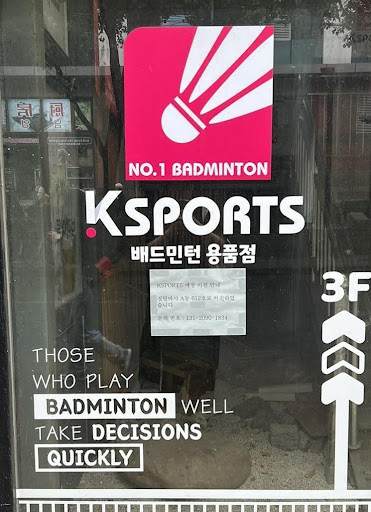
Korean-Chinese-English Signs
The Korean language has been influenced by the globalization of English, which has led to the formation of ‘Konglish’. Konglish is a form of language that has evolved from borrowing lexical elements from English. Korean signs are typically mass-produced and written in English, often incorporating a combination of Chinese and Korean characters, and it transparently showcases the linguistic landscape of Korean streets (Malinowski 201).

A sign displayed in Figure 8 conveys the same meaning in three different languages: “市井婆豆腐牛乳” (shijing po doufu niuru) in Chinese, “팥고물우유” (pat go mul woo yoo) in Korean, and “Grandma Bean Paste Milk” in English. The characters “市井婆” are emphasized to express that the bean paste milk is “grandma’s” or “grandma’s special.” In terms of color saturation, composition, and color modality, the prominent language of this sign is Chinese, and the central idea is “bean paste milk” and “grandma’s” highlighted on the left part of “豆腐牛乳.” However, in the Korean characters, the word “grandma” is not mentioned, which alludes to bean-paste milk being the significant component of this sign.

Korean-only Signs
Korean characters dominate the monolingual signs displayed on the upper level of every building on Korean Street, such as the one in Figure 9 located on the 4th floor of Tianle Place. The sign’s composition and color differentiation are notable features, with Scollon and Scollon’s visual semiotics theory explaining that the narrative of the sign is conveyed through the symbols “superstar” and “microphone.” These symbols index “수퍼스타” (shyu po seu ta), which is dialectically similar to the English word “superstar,” and “가족노래방” (ga jok no rae bang), which translates to family karaoke in English. The Korean character on the sign effectively highlights the importance of the Korean language, while the symbols provide context for the sign’s meaning. The phone number on the sign is located in the lower-right corner, which according to Scollon and Scollon (2003), signifies “real news” information. The main symbol of the sign, the superstar, is prominently displayed in the center with saturated color and a different font from the setting. The use of bold Korean text and the superstar logo highlight the sign’s color modality.
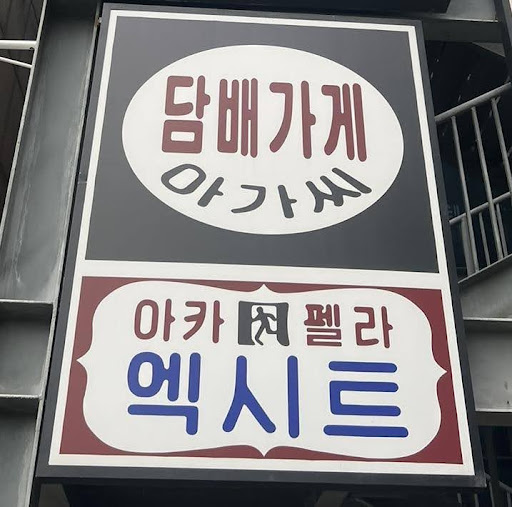
Figure 10 is an example of a monolingual sign on Korean Street where the meaning of the sign is targeted toward a specific audience. For instance, in Figure 10, “담배가게 아가씨” (tam bae ga ge a ga ssi) and “아카펠라 엑시트” (a ka pel la eg si teu) means “tobacco girl” and “acapella exit” in English, and it suggests that this sign is aimed for particular groups of people who understand the context of this sign.
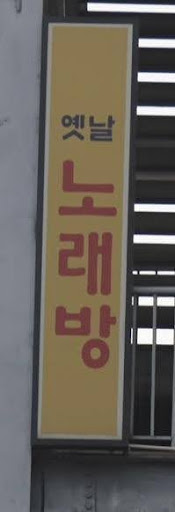
In Figure 11, “옛날 노래방” means “a long ago karaoke,” and it is an example of a monolingual sign. The monolingual signs were not as abundant as multilingual signs in this region, and it could be speculated that the target audience of this sign would be Korean speakers.
Conclusion
The linguistic landscape of Korean Street in Minhang District, Shanghai, is representative of Korean immigrants living in Shanghai, reflecting the local Korean culture and identity. Through the analysis of commercial and noncommercial signage on buildings in the study area, this research has explored the region’s linguistic diversity, highlighting the significant use of Korean language signs in this area. The arrangement of visual semiotics of signs has also been examined, further expanding on the portrayal of multilingualism in signs by using Scollon and Scollon’s theory of visual semiotics. The findings of this study indicate that the Korean language is the main language and represents the identity and origin of residents in this region. Aside from the Korean language, Chinese and English languages were present among the signs. The multilingual use of Korean and Chinese languages was more prominent among other signs, and such signs were not as abundant as they are on Korean Street. However, Korean and English language use on the signs might be related to Korean linguistic derivation from some English words. Furthermore, the position of texts among the signs was analyzed using the visual semiotics theory by counting the visually significant language as the prevailing language of the sign. Further study could explore the sociolinguistic dynamics influencing the prevalence and distribution of multilingual signage in this area.
This study aimed to portray Korean cultural representation through the linguistic landscape of Korean Street. However, the location of commercial buildings was sparse, and the perimeter of the study needed to fully include every commercial building on Korean Street. Additionally, Korean Street itself has no defined perimeter as it is surrounded by residential and other secluded buildings that do not include any signs. Potential setbacks include a lack of local Chinese sources and in-depth research on Korean immigrants in Shanghai, specifically those surrounding Korean Street. Though additional questionnaires were conducted with locals, the result did not contribute to the main claim since local residents were unaware of the exact statistics and history of this region. Furthermore, historical data and numerical data in terms of the population and migration of Korean people in this region need to be studied. Moreover, old signs were abundant in this area, so there was a limitation in terms of counting every sign accurately, further elaborating on accurate numerical data. Future studies could employ ethnographic approaches or engage with the Korean community on Korean Street to gain an understanding of linguistic practices and cultural dynamics within this region.
Works Cited
An, Ran, and Yanyan Zhang. “Language Choice and Identity Construction: Linguistic Landscape of Jianghan Road in Wuhan.” Journal of Multilingual and Multicultural Development, Dec. 2022, pp. 1–18, https://doi.org/10.1080/01434632.2022.2152456.
Backhaus, Peter. Linguistic Landscapes: A Comparative Study of Urban Multilingualism in Tokyo, Bristol, Blue Ridge Summit: Multilingual Matters, 2006. https://doi.org/10.21832/9781853599484 pp. 52–66, https://doi.org/10.21832/9781853599484.
Ben-Rafael, Eliezer. “A Sociological Approach to the Study of Linguistic Landscape.” Linguistic Landscape: Expanding the Scenery, vol. 1, no. 1, edited by Elana Shohamy and Durk Gorter, Routledge, 2009, pp. 40–54, https://doi.org/10.4324/9780203930960-8.
Golden, Judy L. Analyzing the Linguistic Landscape of Japantown and Koreatown in Manhattan, New York. State University of New York College at Fredonia, 2017, pp. 1–116.
Huang, Zuhong, et al. “Shanghai shi waiji renkou kongjian fenbu lishi bianqian yanjiu” [A Historical Study of the Spatial Distribution of Foreigners Living in Shanghai]. Nanfang Renkou [South China Population], vol. 28, no. 3, 2012, pp. 54–64.
Huebner, Thom. “Bangkok’s Linguistic Landscapes: Environmental Print, Codemixing and Language Change.” International Journal of Multilingualism, vol. 3, no. 1, Apr. 2006, pp. 31–51, https://doi.org/10.1080/14790710608668384.
Malinowski, David. “Showing Seeing in the Korean Linguistic Cityscape.” Linguistic Landscape in the City, edited by Elana Shohamy et al., Bristol, Blue Ridge Summit: Multilingual Matters, 2010, pp. 199–216, https://doi.org/10.21832/9781847692993-013.
Ministry of Foreign Affairs of the Republic of Korea. “Consulate General of the Republic of Korea in Shanghai.” Ministry of Foreign Affairs of the Republic of Korea, 2018, overseas.mofa.go.kr/cn-shanghai-zh/wpge/m_500/contents.do.
Scollon, Ron, and Suzie Wong Scollon. Discourses in Place. Routledge, 2003, pp. 1–105, https://doi.org/10.4324/9780203422724.
Spolsky, Bernard. “Prolegomena to a Sociolinguistic Theory of Public Signage.” Linguistic Landscape: Expanding the Scenery, vol. 1, no. 1, edited by Elana Shohamy and Durk Gorter, Routledge, 2009, pp. 33–47, https://doi.org/10.4324/9780203930960-8.
Wang, Ning. “From Shanghai Modern to Shanghai Postmodern: A Cosmopolitan View of China’s Modernization.” Telos, vol. 2017, no. 180, 2017, pp. 87–103, https://doi.org/10.3817/0917180087.
Ye, Zhaoyuan, and Hyeong-Yeon Jeon. “Chinese City Brands and Semiotic Image Scales: A Tourism Perspective.” Social Semiotics, vol. 1, no. 1, June 2020, pp. 1–24, https://doi.org/10.1080/10350330.2020.1769405.